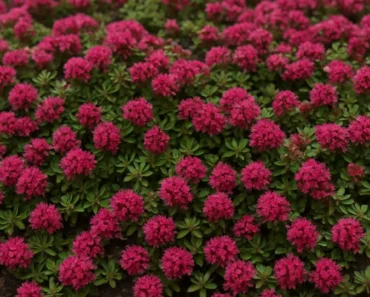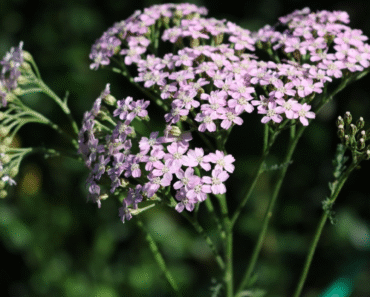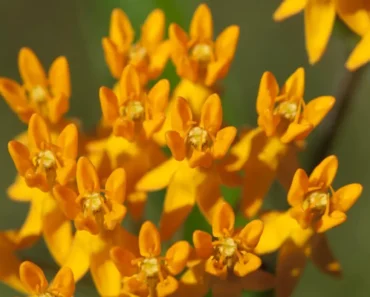
The Chinese Lantern Plant (Physalis alkekengi), with its iconic, bright orange-red papery calyxes resembling festive lanterns, is a striking addition to the fall garden. This definitive guide provides everything you need to know to successfully grow chinese lantern plants, from starting seeds to managing its vigorous nature and harvesting those beautiful pods.
Table of Contents
Growing Chinese Lanterns (Physalis alkekengi) at a Glance: Key to Success
Here are the essential facts you need to know about chinese lanterns care:
- Plant Type: Vigorous, spreading herbaceous perennial
- Primary Attraction: Bright orange-red, lantern-shaped calyxes in fall
- Starting Methods: Commonly from seeds, also by division or purchased plants
- Light: Full sun to partial shade
- Soil: Average, well-draining soil; adaptable
- Watering: Moderate; drought-tolerant once established but prefers consistent moisture
- Hardiness Zones: Typically 3-9
- Key Challenge: Can spread aggressively via rhizomes; containment is often necessary
- Harvesting: Cut stems when calyxes are fully colored but still firm
Meet the Chinese Lantern: More Than Just a Pretty Pod
Understanding your Chinese lantern plant is crucial for successful cultivation and proper garden management.
What is Physalis alkekengi?
The Chinese lantern plant belongs to the nightshade family (Solanaceae), making it a relative of tomatillos, ground cherries, and even tomatoes. This herbaceous perennial originated in Europe and Asia but has become a beloved ornamental plant worldwide for its spectacular autumn display.
The Journey of the Lantern: From Flower to Fruiting Calyx
The transformation of the chinese lantern flower is truly remarkable. In summer, small, inconspicuous white flowers appear along the stems. These modest blooms are easily overlooked, but they’re the beginning of something extraordinary.
After pollination, a green, papery calyx forms around the developing fruit. As autumn approaches, this protective covering gradually transforms into the plant’s signature feature – brilliant orange-red “lanterns” that seem to glow in the fall sunlight. The actual fruit inside is a small cherry-like berry, but it’s the inflated calyx that steals the show.
The Vigorous Spreader: Understanding Its Rhizomatous Growth
Here’s what every gardener must understand: Chinese lanterns spread through underground rhizomes (root-like stems). This spreading habit makes them excellent groundcover in appropriate settings, but it can also make them problematic in formal gardens or small spaces.
The plant sends out runners beneath the soil surface, establishing new plants sometimes several feet away from the original. While this creates beautiful colonies of lanterns, it also means you’ll need a management strategy from day one.

Planting Chinese Lanterns: A Complete Guide from Seed, Division, or Transplant
Learning how to grow chinese lantern plant successfully starts with choosing the right planting method for your situation.
Growing Chinese Lanterns from Seed (Most Popular Method)
Starting from seed is the most economical way to grow chinese lantern plants, and it’s surprisingly straightforward.
Step 1: When to Start Chinese Lantern Seeds
Indoor Starting: Begin 6-8 weeks before your last expected frost date. This gives seedlings time to develop strong root systems before transplanting.
Direct Outdoor Sowing: Wait until after the last frost when soil temperatures consistently reach 60°F (16°C) or higher.
Step 2: Preparing for Seed Starting
Gather these materials:
- Seed trays or 3-4 inch pots
- High-quality seed-starting mix
- Clear plastic covers or humidity domes
- Labels for tracking varieties
Pro Tip: Some gardeners soak seeds overnight in lukewarm water to speed germination, though this isn’t strictly necessary.
Step 3: Sowing Chinese Lantern Seeds
- Fill containers with moistened seed-starting mix
- Sow seeds on the surface – they need light to germinate
- Barely cover with a fine dusting of mix (no more than 1/8 inch)
- Mist gently to avoid disturbing seeds
- Cover with plastic to maintain humidity
Step 4: Germination Care
- Temperature: Maintain 65-70°F (18-21°C) for optimal germination
- Moisture: Keep soil consistently moist but not soggy
- Light: Once sprouts appear (7-14 days), provide bright light
- Ventilation: Remove covers once germination begins to prevent fungal issues
Step 5: Caring for Seedlings
When seedlings have their first true leaves:
- Thin to the strongest seedling per pot
- Provide 12-14 hours of bright light daily
- Water when top of soil feels dry
- Begin “hardening off” 7-10 days before transplanting
Growing Chinese Lanterns from Division
Dividing established plants is an excellent way to expand your collection while controlling spread.
When and How to Divide Established Plants
Best Timing: Early spring (just as growth begins) or fall (after lanterns are harvested)
Division Process:
- Dig up a section of the plant, including roots and rhizomes
- Look for natural division points where shoots emerge
- Use a sharp, clean knife to separate sections
- Each division should have both roots and growing points
- Replant immediately at the same depth as the original
Planting Nursery-Bought Chinese Lantern Plants
Transplanting Potted Plants
- Choose a location considering the plant’s spreading nature
- Dig holes twice as wide as the root ball
- Plant at the same depth as in the container
- Water thoroughly after planting
- Apply a 2-3 inch layer of mulch around (but not touching) the stem
Nurturing Your Chinese Lanterns: Ongoing Care for a Spectacular Display
Proper chinese lanterns care ensures healthy plants and abundant autumn displays.
Light Requirements: Finding the Right Balance
Chinese lanterns thrive in full sun to partial shade. While they’ll produce more flowers and lanterns in full sun, they’re remarkably adaptable to various light conditions. In hot climates, some afternoon shade can be beneficial.
Watering Needs: Consistent Moisture for Best Results
- Establishment Period: Water regularly for the first month after planting
- Mature Plants: Deep, weekly watering during growing season
- Drought Tolerance: Once established, they can handle some drought
- Avoid: Overwatering, which can lead to root rot and excessive foliage growth
Soil Preferences & Fertilizing
Chinese lanterns are refreshingly undemanding:
| Soil Aspect | Preference |
|---|---|
| pH | 6.0-7.0 (slightly acidic to neutral) |
| Drainage | Well-draining; avoid waterlogged conditions |
| Fertility | Average soil; avoid over-fertilizing |
| Texture | Adaptable to various soil types |
Fertilizing Note: Too much fertilizer, especially nitrogen, promotes leafy growth at the expense of flower and lantern production.
Support Considerations
Most Chinese lantern plants don’t require staking, but consider support if:
- Plants grow taller than 3 feet
- Your area experiences strong winds
- You want to create specific garden designs
Containing the Beast: Effective Strategies for Managing Chinese Lantern Spread
This is perhaps the most crucial aspect of learning how to grow chinese lantern plant responsibly.
Why Containment is Often Necessary
Without management, Chinese lanterns can quickly overtake garden beds, competing with other plants and spreading into unwanted areas. The underground rhizomes can travel surprising distances, popping up in unexpected locations.
Planting in Containers (The Easiest Method)
Container Benefits:
- Complete spread control
- Easy to move for design changes
- Suitable for patios and small spaces
- Simplified harvesting
Container Requirements:
- Minimum 18-inch diameter pot
- Drainage holes essential
- High-quality potting mix
- Regular watering (containers dry out faster)
Sinking Strategy: Plant containers in the ground for a natural look while maintaining control.
Using Rhizome Barriers
For in-ground planting with controlled spread:
- Barrier Materials: Heavy-duty plastic sheeting or metal edging
- Installation Depth: At least 18-24 inches deep
- Above-Ground Height: 2-3 inches visible to catch surface runners
- Maintenance: Check annually for runners attempting to escape
Regular Root Pruning and Management
This labor-intensive approach involves:
- Annual inspection of the planting area
- Digging out runners that extend beyond desired boundaries
- Root pruning with a sharp spade around the perimeter
- Removing unwanted shoots as they appear
Choosing Appropriate Locations
Consider areas where spreading is acceptable:
- Wild or naturalized garden sections
- Large, open areas where colonies can develop
- Slopes where erosion control is needed
- Areas separated from formal gardens by hardscaping
The Grand Finale: Harvesting & Using Your Chinese Lanterns
The reward for your efforts comes in autumn when it’s time to harvest those gorgeous lanterns.
When to Harvest for Best Color and Longevity
Perfect timing ensures the longest-lasting dried displays:
- Color Check: Calyxes should be fully orange-red
- Firmness Test: Lanterns should feel papery but not brittle
- Timing: Usually late September through October
- Weather Consideration: Harvest before hard frost for best preservation
How to Harvest and Dry Chinese Lanterns
Harvesting Process:
- Cut stems 12-18 inches long in the morning after dew evaporates
- Remove all leaves (they’ll turn brown and detract from the display)
- Inspect for any damaged or imperfect lanterns
Drying Methods:
| Method | Process | Timeline | Results |
|---|---|---|---|
| Air Drying | Hang upside down in dry, ventilated area | 2-3 weeks | Natural, slightly rustic look |
| Glycerin Treatment | Submerge stems in 1:2 glycerin/water solution | 1 week | More flexible, longer-lasting |
| Pressing | Individual lanterns between papers | 1-2 weeks | Flat decorations for crafts |
Creative Uses for Dried Chinese Lanterns
The possibilities are endless:
- Fall Wreaths: Combine with autumn foliage and berries
- Table Arrangements: Mix with branches and seasonal flowers
- Holiday Decorations: String lights through lanterns for magical displays
- Craft Projects: Use in potpourri, pressed flower art, or seasonal garlands
- Gift Giving: Share stems with friends for their fall decorating
Chinese Lantern Plant SOS: Identifying and Solving Common Issues
Even with proper care, you might encounter these challenges:
| Problem | Likely Causes | Solutions |
|---|---|---|
| Few or no lanterns | Too much shade, plant too young, over-fertilizing | Move to sunnier location, wait for maturity, reduce nitrogen |
| Flea beetle damage | Small holes in leaves | Use row covers early season, beneficial insects, organic sprays |
| Aphid infestations | Soft-bodied insects on stems | Encourage ladybugs, horticultural soap spray, strong water spray |
| Overly aggressive spread | Natural plant behavior | Implement containment strategies, regular management |
| Poor germination | Old seeds, incorrect temperature | Use fresh seeds, maintain proper temperature and moisture |
A Note on Edibility: Are Chinese Lantern Fruits Safe to Eat?
This is a common question that deserves a clear answer. While the fruit inside the calyx of Physalis alkekengi is technically edible when fully ripe, it’s generally not recommended for consumption, especially from ornamental plants.
Important Distinctions:
- Ornamental Chinese Lanterns (Physalis alkekengi): Grown for decoration, not bred for taste or safety
- Edible Ground Cherries (Physalis pruinosa, P. peruviana): Specifically cultivated for consumption
Safety Recommendation: Enjoy Chinese lanterns for their spectacular ornamental value rather than as food. If you’re interested in edible physalis, seek out varieties specifically bred for culinary use.
Your Top Chinese Lantern Plant Questions Answered (Expert FAQ)
How long does it take for Chinese lanterns to grow from seed?
From seed to harvest typically takes 6-7 months. Seeds started indoors in February will produce harvestable lanterns by September or October of the same year.
Are Chinese lantern plants invasive?
While not technically invasive in most regions, they can be aggressively spreading. The key is proactive management from the beginning rather than trying to control established colonies later.
Do Chinese lanterns come back every year?
Yes! Chinese lanterns are hardy perennials that return annually in zones 3-9. Established plants often produce more lanterns each successive year.
Can I grow Chinese lanterns in pots?
Absolutely, and it’s often the best approach for most gardeners. Container growing provides complete spread control while still allowing you to enjoy the beautiful autumn display.
When do Chinese lanterns turn orange?
The transformation typically begins in late summer and peaks in early fall (September-October). The exact timing depends on your climate and the specific growing season.
How do I prevent Chinese lanterns from taking over my garden?
Use one or more containment strategies: plant in containers, install rhizome barriers, choose appropriate locations where spread is acceptable, or commit to regular root pruning and management.
Your Journey to a Dazzling Chinese Lantern Display
Growing Chinese lantern plants successfully combines understanding their unique characteristics with implementing smart management strategies. These remarkable plants offer unparalleled autumn beauty when grown responsibly, creating stunning displays that can be enjoyed both in the garden and as long-lasting dried arrangements.
Remember that the key to success lies in planning for their vigorous nature from the start. Whether you choose container growing, barrier installation, or designated wild areas, having a management plan ensures you’ll enjoy the benefits without the headaches.
The effort invested in learning how to grow chinese lantern plant properly pays dividends every autumn when those glowing orange lanterns light up your garden and home decorations. With proper chinese lanterns care and thoughtful placement, these plants become treasured elements of your seasonal garden display.
Call to Action: What are your favorite ways to use Chinese Lanterns, or how do you manage their spread? Share your tips and questions in the comments below – let’s learn from each other’s experiences with these fascinating plants!
Author
George Wine is a seasoned gardening expert with over 20 years of experience in the field of horticulture. His passion for plants and nature has driven his career, where he has honed his skills in various aspects of gardening, from landscape design to plant care. George holds a Master of Science in Horticulture from the University of California, Davis (UC Davis), a prestigious institution known for its research and advancements in plant science.
Throughout his career, George has worked with a diverse range of clients, offering tailored solutions to enhance outdoor spaces and create thriving gardens. His knowledge and expertise allow him to provide invaluable advice, ensuring that both novice and experienced gardeners achieve their gardening goals. Whether you’re looking for tips on sustainable gardening practices, innovative design ideas, or advice on specific plant species, George is here to help you cultivate the garden of your dreams.






